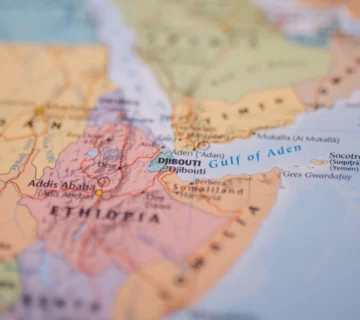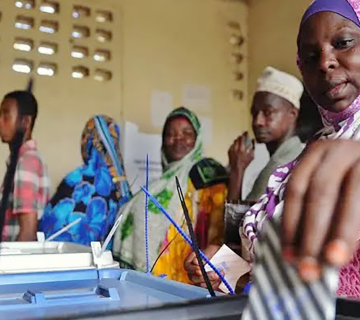Kenya has been cementing its reputation as a country of many firsts in recent times. Its head-turning feats range from game-changing technological innovations such as M-Pesa (mobile cash transfer system) to the March 2018 handshake (political settlement that defused rising post-poll tensions, and stalled related violence). The latest addition to these feats is the scheduled implementation of three, first-of-their-kind, nationwide audit processes in a year: biometric registration of citizens, 2019 census, and demonetization. While most Kenyans understand the importance of updated statistics and a thriving economy for government planning and development, they have generally been misreading the government’s intentions in the implementation of the three processes. Meeting state obligations without making it difficult for citizens to take up their responsibilities to the state (statecraft), coupled with the willingness of citizens to fulfil their civic duties, will help Kenya realize her Big 4 Agenda, and Vision 2030.
Misreading the Government
Government-citizen relations in Kenya are generally characterised by scandals and opacity, which over the years have created mistrust between the state and its people. It is, therefore, not for nothing that Kenyans approach even well-intended government initiatives to eradicate disease, ignorance, and poverty with caution. The government raised eye brows when, in October 2014, for example, it targeted some women in the child-bearing age (15-45 years) with the gender-blind tetanus vaccine. It later emerged that a few of the tested samples contained birth control hormones, but the government distanced itself from these claims, leaving Kenyans feeling insecure. Furthermore, government has lost billions of shillings through corruption and scandals over agriculture-supporting infrastructure (such as roads and irrigation dams) and produce (maize, and sugar, for example) that threaten its development agenda. In sum, such caution is not misplaced in a country where, according to the 2019 Global Corruption Barometer – Africa, 45 per cent of Kenyans have paid a bribe to use a public service, and 67 per cent think corruption has worsened in the last 12 months.
So, when the Ministry of Interior and Coordination for National Government announced it was going to roll out its KES 7.7 billion National Integrated Identity Management System (NIIMS, Huduma Number) program that was established in 2018 to register citizens, and create a centralized, digitalized, master population database in the first half of 2019 – seemingly hurriedly, and without sufficient public awareness campaigns – many Kenyans thought their government was up to something sinister. This was, after all, the first time the government was collecting the biometric data of its citizens (including children) and resident foreigners en mass.
Many Kenyans have questioned the timing of this historic exercise (only a few months away from the 2019 Kenya Population and Housing Census). They also questioned the real intended use of the data (creating database, or enhancing national security, and curbing crime). There were talks of the inability of citizens to obtain the number after the set deadline, and of their hindered access to basic government services without a personal, citizen identifier number (Huduma Number) in the future. Citizens are also concerned about the safety of their images and fingerprints (from mishandling, misuse, or hackers). The government has said that it collects, transmits, and stores all such data in line with best global practice and standards. However, the citizens are not necessarily convinced. Concerns over data safety peaked earlier this year when it emerged that President Uhuru Kenyatta was impersonated, and a businessman subsequently conned of several KES millions, bringing concerns over data safety into focus. The citizens’ unease could be because they had not been sufficiently educated and involved in the process.
The government is now undertaking the 2019 Kenya Population and Housing Census. The timing of this exercise makes it unique. It has been almost 15 years since Kenya adopted a harmonized approach to register citizens and resident aliens in the country (the Integrated Population Registration System, IPRS), and about three months after Huduma Number program was rolled out. Many Kenyans are still in the dark about the extent to which the government has succeeded in harmonizing and integrating Kenya’s demographic. Additionally, two mass registration exercises in a year duplicates similar efforts, to the chagrin of the already overburdened, largely marginalized tax payer. As with the mass biometric registration of citizens in May 2019, Kenyans who have expressed reluctance to be counted again have been threatened. This time, the threats have bordered on harassment (repeated visits in the course of the week – August 24-31, 2019), and legal action (fines, imprisonment). Such ‘threats’ seem to spell mischief, and confirm the fears some citizens have had of the two registration exercises.
Unplanned Planning
The citizens were not the only ones who were largely unprepared for the ongoing head count, judging from the changes that the government has made to the timing of the Census in the past few days. Initially, the Census was scheduled to take place on two days, August 24, and August 31. The government then changed the number of days from two to a week (from August 24-31, 2019) and the counting period from the initial 6 am to 6pm (on the two days) to 6am to 10pm during the week in urban areas (through Interior Principal Secretary, Karanja Kibicho). There has been no mention of what this changes mean for Kenyans in rural areas, and in the diaspora. It seems that the government did not anticipate that it would take more time to count citizens in the densely populated areas of the country, and plan accordingly (deploy more skilled enumerators, for example). Such situations paint the government in bad light, and create doubt in citizens’ mind over its ability to make concrete development plans.
Kenya is withdrawing and retiring its existing KES 1,000 note, and introducing its next generation currency. This, according to the legal tender establishing organization, Central Bank of Kenya (CBK), is to rid the country of fake currency, and illicit financing, and, in the process reduce the runaway corruption that is stifling the country’s economic growth, and by extension, Kenya’s development. It is also in observance with the 2010 Constitution that requires that legal tender be devoid of human portraits, which the existing ones have had. As with the mass registration exercises, some Kenyans have voiced their disappointment at the seeming secrecy in the handling of this demonetization exercise. Activist Okiya Omtatah, for example, has challenged the inclusion of a statue of Kenya’s first president, Jomo Kenyatta, on grounds that it contravenes the 2010 Constitution. It is unclear whether other existing notes will also be withdrawn by October 1, 2019 too, and the government will do differently to prevent the forgery of the new currency, and curb illicit financing and corruption. There are also some Kenyans who still do not understand that they will not be able to buy goods and pay for services using the KES 1,000 as the ‘old’ note will have zero monetary value by October 2019. CBK should have initiated a countrywide public awareness drive, and allowed for sufficient public participation before designing, launching (in June 2019), and circulating the ‘new’ notes. For CBK, withdrawing currency on short notice could be a measure to realize and safeguard the goals of the 2019 demonetization exercise.
Short End of the Stick
While Kenya’s obligation to serve (fulfil basic needs of Kenyans) and protect her citizens (from internal and external threats) are legalized by several frameworks which include 2010 Constitution of Kenya, Registration of Persons Act, CAP 107, Kenya Citizens and Foreign Nationals Registration Act, Access to Information Act, and the Computer Misuses and Cybercrimes Act; the 2010 Constitution provides for public participation. This provision has largely been overlooked in the ongoing nationwide citizen and currency auditing efforts. Thus, the government missed the opportunities to reassure Kenyans of its efforts and commitment to serve Kenyans and secure the country.
There is little doubt that updated data is useful for equitable allocation of national and county resources. However, the wisdom of undertaking two relatively similar mass registration exercises in under a year is questionable. A national census is undertaken once every decade, and the goals of the two campaigns are different. Still, the outcomes are fairly similar. The definitive cost of these exercises is yet to be established as some of the exercises are still ongoing, but is likely to be billions of shillings. Kenya would have used its public resources (money and work force) better if it would have combined the August 2019 Census with the May 2019 mass biometric registration exercise. The government should have also involved Kenyans more in these programs, and in the demonetization. Doing this would have provided the government with opportunities to engage with its citizens, and reduce antagonistic state-citizen approaches, improving relations between the two actors. Improved relations would translate to the support of the masses, which is a crucial element in the realization of both the Big Four Agenda, and Vision 2030. Engaged citizens are more likely than antagonized ones to obey the law, serve on a jury, vote, and pay taxes, which would accelerate Kenya’s development.
Roselyne Omondi is the Associate Director, Research, at the HORN Institute.
Photo: Charles Owino, Police Spokesperson, addresses the media during inter-ministerial press briefing on the 2019 Population and Housing Census on August 24, 2019 (Photo Credit: KNBS)



